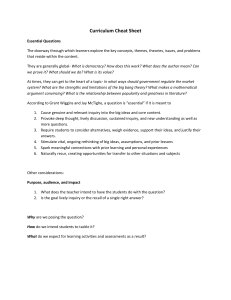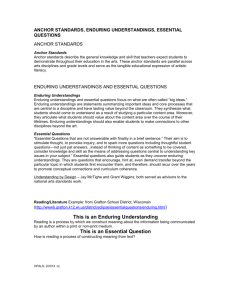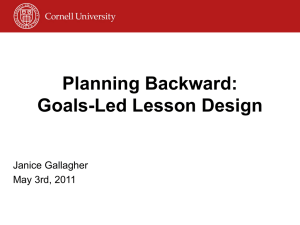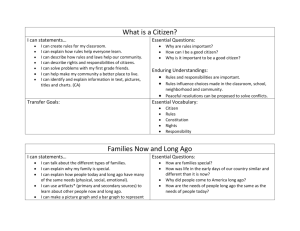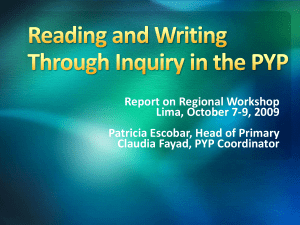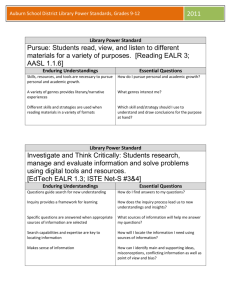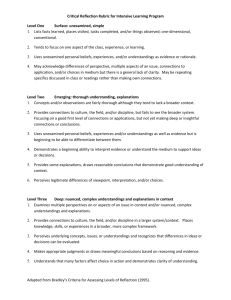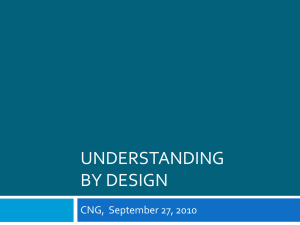Stage+1
advertisement
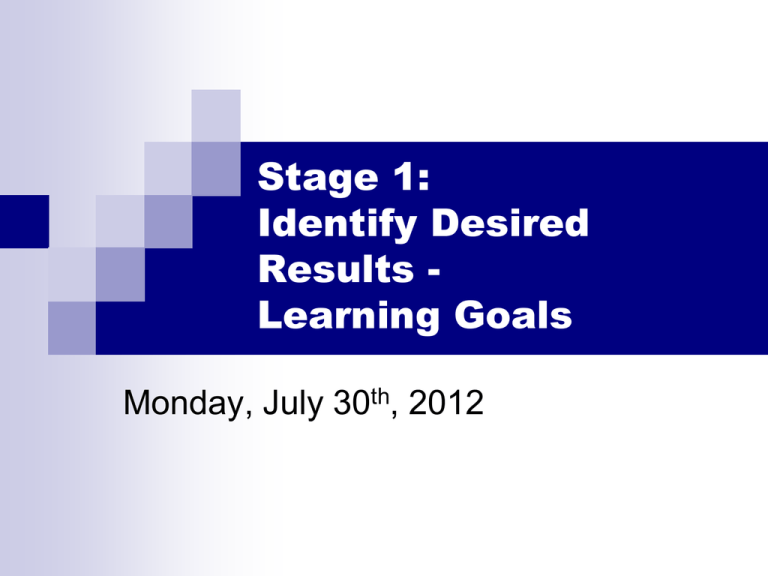
Stage 1: Identify Desired Results Learning Goals Monday, July 30th, 2012 What is Understanding by Design? Traditional Lesson Planning Find cool activities to use in the class. Figure out how to teach and grade activities. Align activities to the standards and core curriculum. UBD Planning Understand the larger picture of what needs to be learned. Plan for students learning and understanding Develop cool activities to use in class that stay with the student FOREVER! What You Need to do for Your Lesson Plan Stage 1- Establishing what is to be learned. Stage 2- Determine how the learning is accomplished. Stage 3- Develop the COOL learning activities. Don’t forget about technology integration! What will you do? Complete your lesson plan and supplements. Have them ready by Thursday morning. Lesson Plan Template We will complete the Established Goal(s) section on Wednesday. Established Goal(s): (National, State, District Standards) Stage 1: Identify Desired Results - Learning Goals Step 1: Enduring Understandings Step 2: Essential Questions Step 3: Knowledge and Skills Step 4: Six Facets of Understanding Step 1: Enduring Understandings What Enduring Understandings are desired? Step 1: Enduring Understandings • Big ideas that we want students to “get inside of” and retain after the details are forgotten. • Provide a larger purpose for learning the targeted content: they implicitly answer the question, “Why is this topic worth studying?” Step 1: Enduring Understandings They are the unit concepts that: 1. Have lasting value beyond the classroom 2. Will be retained after the details have been forgotten 3. Reside at the heart of the discipline 4. Uncover the concept by “doing” the subject 5. Offer potential for engaging students Enduring Understandings Examples: Specify something to be understood. Focus on big ideasabstract and transferable. The understanding will need to be uncovered, because it is abstract and not immediately obvious. Non-examples: Phrase, not sentence Refers to big ideas, but offers no specific claims Simply states straightforward fact, no inquiry is required Truism: fails to specify what we want the learner to understand Refers to set of skills, but does not offer transferable strategies or principles about them Examples of Understandings Non-examples of Understandings An effective story engages the reader by setting up tensionsthrough questions, mysteries, dilemmas, uncertainties- about what will happen next. Audience When liquid water disappears, it turns into water vapor and can reappear as liquid if the air is cooled. Water Correlation Things does not ensure and purpose. covers three-fourths of the earth’s surface. are always changing. causality. Decoding is necessary but not sufficient in reading for meaning. Sounding out, looking at pictures. Sample Enduring Understandings Writing from another person’s point of view can help us to better understand the world, ourselves, and others. Sometimes a correct mathematical answer is not the best solution to messy, “real-world” problems. Cultural customs in the Hispanic countries regarding interactions between individuals determine if conversation is formal and informal. Step 2: Essential Questions What Essential Questions will be considered? Step 2: Essential Questions Point to the heart of the discipline Recur naturally Raise other important questions Provide subject- and topic- specific doorways to enduring understandings Have no obvious “right” answer Are deliberately framed to provoke and sustain student interest Tips for using Essential Questions Organize programs, courses, units of study, and lessons around the questions. Select or design assessment tasks that are explicitly linked to the questions. Edit the questions to make them as engaging and provocative as possible for the particular age group. Derive and design specific concrete exploratory activities and inquiries for each question. Examples of Essential Questions How can macroeconomics inform microeconomics (and vice versa)? How are sounds and silence organized in various musical forms? To what extent can use of formal and informal conversation techniques demonstrate cultural understanding? What are the pros and cons of technological progress? Overarching vs Topical • Transcend the content knowledge of the unit • Are specific to the unit topic • Could appropriately express a given concept found in most grade levels and courses • Involve generalizations derived from the specific content knowledge and skills of the unit Overarching • How do effective writers hook and hold their readers? • Is history the story told by the “winners”? • How are materials recycled or disposed of? • Does art have a message? vs Topical • What is unique about the mystery genre? • Does separation of powers create a deadlock? • How do the structure and behavior of insects enable them to survive? • What do masks and their use reveal about the culture? Step 3: Knowledge and Skills Students will know / be able to Step 3: Knowledge and Skills Other important pieces of knowledge and skills discovered as you identify the essential understandings These should be included because they are related to the essential understanding or focus of the unit. Key Knowledge and Skills Vocabulary Terminology Definitions Key factual information Formulas Critical details Important events and people Sequence and timelines Basic skills Communication skills Thinking skills Research, inquiry, investigation skills Study skills Interpersonal, group skills Technology skills Examples of Knowledge Students will know: – Ways artists employ various technologies – Appropriate uses for “tú” vs. Ud. – Relevant vocabulary words – How to describe and compare common items using measurement Step 4: What are Six Facets of Understanding? Students may exhibit understanding through six interrelated ability levels: – – – – – – Explanation Interpretation Application Perspective Empathy Self-knowledge Explanation Students provide evidence to back up claims and assertions and provide thorough, supported, and justifiable accounts of phenomena, facts, and data. Misconceptions: – If the student gives a correct answer to a complex and demanding question, he must have an indepth understanding. – If the student cannot write an explanation of his views, he lacks understanding. Interpretation Students tell meaningful stories, offer apt translations, provide revealing historical or personal dimensions to ideas and events, and make learning personal through images, anecdotes, analogies, and models. Misconception: – If the student offers an engaged and rich response to literature, he understands that work of literature. Application Students effectively use and adapt what they know within new settings and real-world situations, including authentic problem-solving, decisionmaking, and conflict resolution. Misconceptions: – Any effective performance with knowledge indicates understanding of that knowledge. – Any ineffective performance with knowledge indicates a lack of understanding of that knowledge. Perspective Students observe both the big picture and the multiple perspectives that comprise it, examining and assessing various points of view or conflicting issues surrounding a topic, issue, or theme. Misconception: – Having an opinion equals having a perspective. Empathy Students walk in the shoes of a fictional character, historical figure, or contemporary individual. They find value in what at first may appear to them as odd, alien, or implausible. Misconceptions: – Empathy is affect, synonymous with sympathy or heartfelt rapport. – Empathy requires agreement with the point of view in question. Self-Knowledge Students monitor their own comprehension and revise, rethink, reflect, and revisit their growing understanding. They also can articulate what they understand- and fail to understand- in what they are studying or investigating. Misconception: – Self-knowledge equals self-centeredness. Your Homework… Complete Understandings, Questions, Knowledge and Skills. Your Homework… Start thinking of how students will demonstrate their knowledge.


